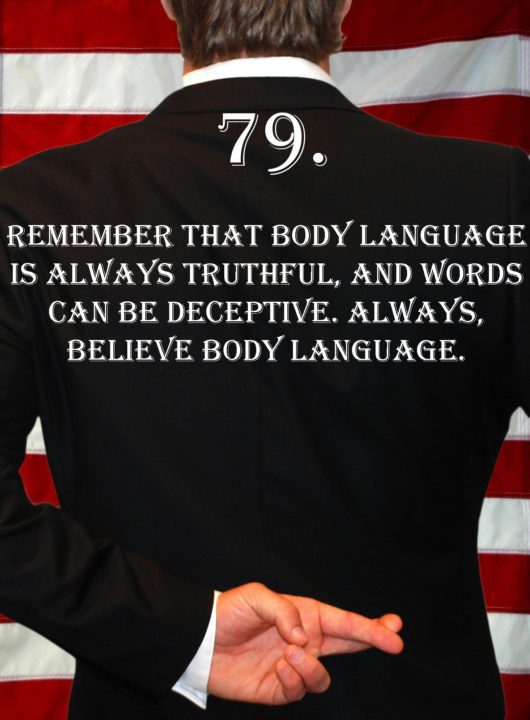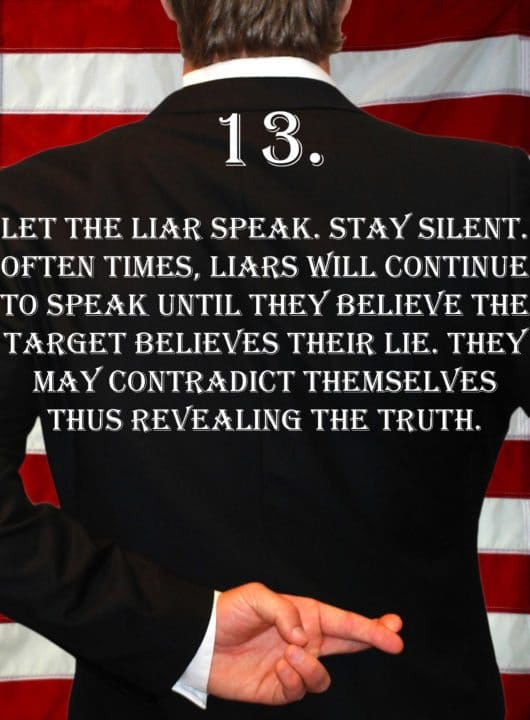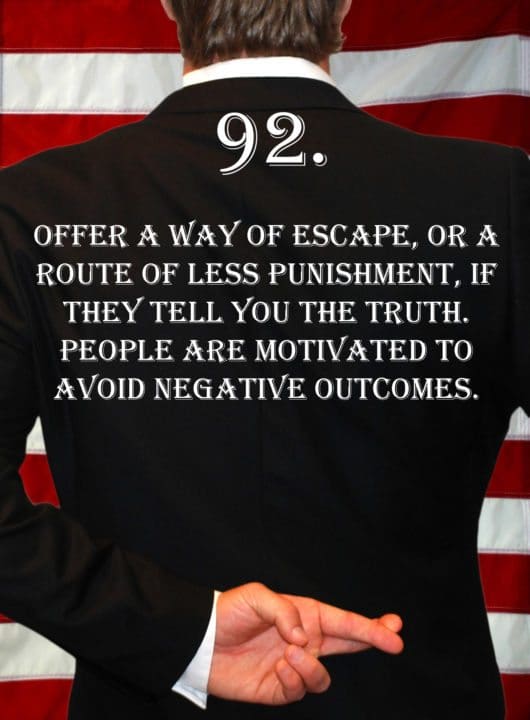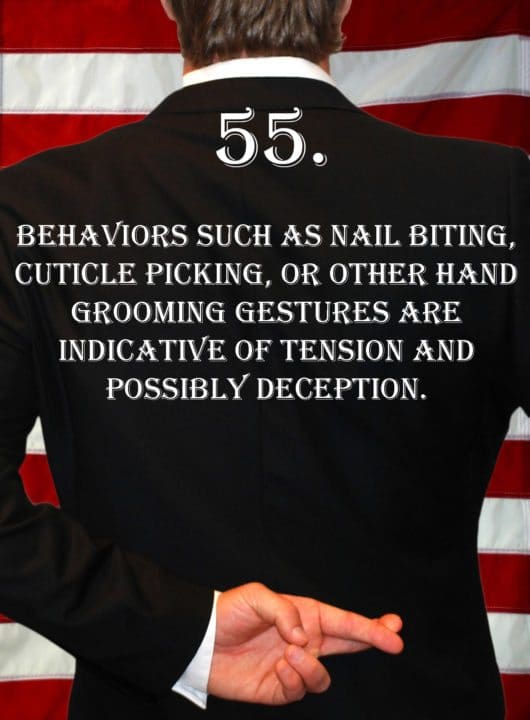
Deception Tip 79:
Remember that body language is always truthful, and words can be deceptive. Always, believe body language.
Listen To The Podcast!
E79 – Believe Body Language – Deception Tips Podcast – Click Here To Subscribe
Podcast Transcript
Hello and welcome to the deception tips podcast where you will learn amazing cues to detect deceit that will help you read people like never before. I’m your host Spencer Coffman, let’s get started.
Welcome to episode 79 of the Deception Tips podcast. Hopefully, you’ve enjoyed your week and had a chance to practice all of the different Deception Tips that we’ve gone over, there have been several of them. Of course, this is number 79, which means we’ve gone over 78 different Deception Tips.
Hopefully, you have been thinking about them and watching yourself, looking inward and examining yourself, a little bit of self-awareness, to see if you’ve noticed any of these behaviors on your own body.
If you have, that you’ve been thinking about them and wondering whether or not you were lying or if they were simply an outward behavior that didn’t mean deception.
If so, remember those, and then when you see them on other people you can think about how they looked on yourself and what you were going through to understand a little bit more about what they may be going through.
If they’re lying or if they were experiencing the same thing you were experiencing, give yourself a little bit more awareness of not only your own actions but also other people’s actions and what might be going on in their minds.
You may say, ‘oh, that doesn’t make sense because if something happens to me and I think one way, how would that make sense and how would it be the same on another person?’ Well, we’re all human beings and generally, when we have different behavioral thoughts and actions, they are pretty much standard. So, they may not be universal across all humans with their behavior, actions, and thoughts but they are pretty standard.
The behaviors and these deception tips and unconscious nonverbal and unconscious verbal behavior, that is universal. The thoughts behind them are not universal but it is pretty standard because we’re all humans, and we all behave in a variety of the same ways. That may be a little confusing but we’re a general pool, we’re the same species, we have the same mannerisms, characteristics, etc.
So, last week we talked about how it was important for you to listen to the entire story. The reason being, that words have more than one meaning, so you need to use context to determine whether or not people are being deceptive.
Basically, this means that when you are in conversation with someone, you need to pay attention from beginning to end. You can’t simply cut them off and assume the rest of their story or pretend you know or think you know what they’re going to say next.
You need to let them say what they’re saying and tell their story, that way when you are detecting deception, you’ll know which parts of their story have holes in it or flaws. Of course, if you know they’re lying instantly because they exhibited some kind of a sign or they slipped up in the beginning, you can stop them and call them out right there if the situation dictates it.
They will know that there’s no point to continue lying to you because you’ve already caught them in one lie, so now you want the truth, you mean business. In general, listen to the whole story, pay attention so you get the big picture, and you want the full context. In addition, the more you allow them to talk, the more opportunity you have to detect deception and spot those lies.
Remember, silence is also golden, if you can make them have that awkward silence and pause then they will get even more uncomfortable and start to slip up a lot more.
Remember, silence is already awkward and when they are lying, they’re in an awkward situation anyway, they’re stressed, they’re tense. So, if you stay silent, their tension is going to go from bad to worse and they become even more upset or anxious about that.
We’ve talked about that a couple of times in the past, if you don’t remember those deception tips, I encourage you to check them out, you can easily find the videos on YouTube. Otherwise, you can find them in the Deception Tips eBook, you can find them in the Deception Tips book or The Deception Tips Revised and Expanded, and also back in the podcast, of course.
In case you need a little reminder on where they were, we had Deception Tip episode number 69, Become Silent and Deception Tip episode 13, Stay Silent, so you can check those out at your leisure. Today, we are talking about a new deception tip, remember it’s number 79, it is also about body language in general or detecting body language in general, exactly like last week.
So, this one is more a reminder to you that body language is truthful. So, here it is, Deception Tip number 79. Remember that body language is always truthful and words can be deceptive. Always believe body language. Here it is again, Deception Tip number 79. Remember that body language is always truthful and words can be deceptive. Always believe body language.
This is very important, words can be deceptive. Of course, they can because how else do people lie. Remember that sometimes people can lie non-verbally as well as verbally, by saying which direction should I go and they may point you in the wrong direction, that would be a nonverbal lie or a nonverbal form of deception.
They may also hide something from you, whether it’s under their hand or in one hand versus another like magicians when they’re finding the little pea under the three cups, they’re deceiving you and they’re doing it non-verbally. So, people can lie non-verbally but in general, body language is what you want to pay attention to because body language is truthful.
Now, that’s not entirely true because not all body language is truthful. I simply explained about pointing someone in the wrong direction or the Magicians moving the cups around, that is untruthful body language. What I’m saying here is unconscious body language is always true. The reason is that remember there is that huge battle between the conscious and the unconscious.
The conscious wants the lie to succeed, the unconscious has that strong desire for the truth to come out, it wants to be truthful, it is truthful and it wants to defeat the unconscious’ lies. So, there’s that battle going back and forth, as the conscience tells lies and does its thing, self-serving, the unconscious is silently pushing forward the truth.
Letting little nonverbal behaviors slip, letting vocal behaviors slip, all kinds of unconscious deceptive gestures and language, speech, etc. So, you need to watch the unconscious and remember again that the words are harder to decipher when it comes to unconscious stuff. So, that’s why if you pay attention to the body language, remember how many signs, they’re all over the place.
We’ve got the legs, the face, head and neck, chest, shoulders, arms, everywhere. There are so much more areas on the body than simply the spoken words. So, if you pay attention to the body language, you have a much better chance of detecting deception. We’re going to talk a lot more about all of this coming up right after this.
Tired of being lied to day in and day out? Want to learn how to spot a liar? Get the revised and expanded edition of the Deception Tips e-book on spencercoffman.com.
Welcome back to Deception Tip episode number 79. Today, we’re talking about how body language is always truthful, that’s specifically unconscious body language, it’s always truthful. There’s that big battle going on between the conscious and the unconscious, we’ve talked about it many times. The conscious wants the lie to succeed, the unconscious wants the truth.
There’s a battle, they’re fighting back and forth for the front line, for the spotlight on the human body. So, if you pay attention to the nonverbal signs of deception, you have a huge chance of spotting these lies and detecting deceit. We talked about several different signs of deception, and you can have that repertoire in your head.
I also encourage you to have the deception tips ebook, it’s very simple, each one of the images in a nice little ebook fashion that you can swipe through as you’re standing in line or waiting around or in the doctor’s office. They will help you keep these deception tips sharp in your mind so that you’ll always be thinking about what to look for and how to see them and when to spot lie.
After a while, it simply becomes a habit, you’ll watch people and you’ll see their interactions and you will have all of these tips in your mind and you’ll just see and you’ll say something’s not right, something’s going on.
They may be lying or they want to do this or XYZ and you may not know exactly what you saw as far as oh, I believe this because I saw this behavior and it links with this behavior and it formed this pattern and this cluster and this is what it means.
You may not even remember all of those anymore, it becomes natural, it becomes second nature and then it will become your first nature and it’s just a part of you after a while. You’ll just see it, it’s there and you won’t know what signs you saw or what this and this.
Eventually, you’ll start to put them back in but for a while, when you start learning, you’re just going to start seeing it and you may not even know exactly what you saw, you just know what it means.
So, keep that in mind if all of a sudden you feel like you’re starting to forget all the stuff you learned but you’re still spotting and understanding people and body language.
You’re understanding what they’re thinking and what they care about and knowing more about them. You are still interpreting their body language and their nonverbal and verbal signs of unconscious behavior, you’re not forgetting it.
Continue to pay attention to the body language that people exhibit because it is truthful. There are so many different signs, we’ve only talked about 78 of them, 79 today, but this is kind of a general tip and they are all over people’s bodies. They can’t help it, remember that these signs are universal, they are the same across all species no matter what language they speak.
That’s another very important point because you may think well, I can only detect deception when I’m talking with someone. No, that’s inaccurate, you can detect deception, read people, and understand body language even if you’re not speaking with someone.
In fact, as I’ve mentioned before, when you’re starting out, it’s often easier for you to detect deception and read body language when you are not speaking with someone when you are observing.
Therefore, if you have a situation where you need to find out something from someone, write down your questions or write down what you need asked, or what you need said, or what you want someone to say. Give it to somebody and have them do the asking then you can sit back and watch the entire interaction because if you’re not focused on what you’re saying you can be more focused on what you’re seeing.
Alright, I’m going to say that again, if you’re not focused on what you’re saying, you’ll be more focused on what you’re seeing. That’s important because then you can sit back and observe the entire situation and you’ll see more body language. You’ll hear more signs coming from their verbal, spoken language as well.
Now, if you have a situation where it’s in a different language, don’t worry about it, put yourself behind the glass or in another room or watch the video camera or who knows what and you can watch the body language without the interaction. A tip that I’ve mentioned before on how to improve your body language detecting skills was watching the TV on mute.
That’s something I mentioned before, we’re going to talk about it in a future tip in more detail, so I’m not going to get into it right now, but it is something that will help you.
When you are watching other people, you want to be analyzing the entire situation. If you’re thinking about what you’re going to say next or how you’re going to respond to something, your mind is half distracted by what you’re talking about and what they’re talking about.
If you can simply watch the body language, you’ll have a lot more success in detecting deception. Keep that in mind when you feel like you should be the one doing the interrogation or when you feel like you should be doing the talking.
You can let someone else talk, you can watch the situation, and then you may gain a lot more understanding of what that person is thinking, what they may want, what they may be saying, if they’re being truthful, deceptive, etc.
You’ll start to understand a lot more about what’s really happening around you, so pay attention to body language. It is the only thing that is truthful no matter what as long as it is unconscious body language or little signs.
You’ve learned how to see them, you’ll start to see them a lot more, they’re the little unconscious gestures, they are 100% of the time truthful because the unconscious wants the truth to come out.
It may not always be contradicting the conscious and it may not always be representative of a lie, but it’s always a truthful behavior that they want to express, they being the unconscious. So, keep that in mind, you need to pay attention to unconscious gestures, behaviors, vocal slips, etc. The unconscious is always truthful.
So, I want to thank you for listening to this week’s episode of the Deception Tips podcast. I hope that you’ll share it with your friends, subscribe to the feed, check out the deception tips videos, the blog and take a look at the books I have available and, as always, tune in next week for a new deception tip.
Video Transcript
Hey guys, my name is Spencer Coffman, thank you for watching the Deception Tips videos. They’re all about teaching you how to read people and detect deception so that you will be able to tell if someone is lying to you. Today, we are going to talk about just a general concept of this whole thing and what you need to look and what is important for you to believe.
Remember, when people talk, they’re saying two different types, they are speaking two languages. Number one is that audible language that you’re hearing, number two is that hidden language that everybody speaks but almost nobody understands and that’s body language. Hopefully, through the course of all these videos, if you checked out the podcasts, blog posts, or any of that other material that’s out there then you are starting and you can understand this body language.
One of these languages is truthful all the time and that is body language, so body language is what you need to believe which is what we are going to be talking more about today. So, here it is, this is Deception Tip number 79. Remember that body language is always truthful, and words can be deceptive. Always believe body language.
Body language is always truthful, why is this? This is because when people speak, we’re speaking from our conscious and when body language happens it is coming from the unconscious. Unless it’s something that’s fake then it could be coming from the conscious.
Remember we’ve talked about that with fake body language and fake expressions that they aren’t going to be symmetrical, congruent, spontaneous, simultaneous, all of those big words. They’re not going to match up with other things, with speech, with each other, with sides of the body, etc. You can review all of that in the past deception tips.
So, body language is truthful because it is coming from the unconscious. Remember the conscious and the unconscious are battling back and forth, the conscience is trying to get that lie out, the unconscious is trying to push the truth. When we’re consciously telling that lie through verbal, spoken language, the unconscious is working behind the scenes in body language.
Remember all of these tips we’ve talked about, whether it’s certain things with facial expressions, gestures, hands touching the face, different finger gestures, lips, eyes or any of these different things that we’ve been talking about, these unconscious gestures. So, what you need to do is believe the body language, pay attention to body language as well as listening to what someone is saying.
There are vocal slip-ups and that’s unconscious as well, so the unconscious is pushing itself out through body language and sometimes through spoken language. Spoken language can be tricky because sometimes it’s false, sometimes it’s true, so we don’t really know but with body language, we’re certain because body language is always truthful.
So, pay attention to that, look for those patterns and look for those clusters of behavior because when you start seeing more than one, now you know it really is. If it’s just one sign like you just notice something, maybe someone touches their nose or they shrug a shoulder and you say, well, that’s one thing, it could have been anything.
Remember way back in number one when we talked about arm folding, there could be multiple reasons. Maybe they’re cold, maybe they are trying to huddle up, maybe they need a hug, or maybe it’s because they’re being withholding and defensive, so there could be more than one reason for any of these signs. Even though folding the arms is an unconscious gesture, it could be done consciously, maybe I folded it consciously because I’m cold.
So, remember that with all of these tips, there is more than one reason for any of them, so that’s why you have to look for those clusters because the patterns and the clusters of behavior are going to be displayed unconsciously. If someone is lying, there will always be more than one sign and if you’re paying attention to that and you believe that body language as things happen, you’ll start to see more than one thing.
You’ll say, okay, this sign happened, now this happened, now this happened, that’s starting to become a cluster and a pattern of behaviors, I’m pretty sure that person’s lying, why? It is because I looked at the body language and I know body language is always telling the truth and right now that body language is not going with whatever they’re saying, so something’s off.
You don’t know what they’re lying about, you don’t know whether it’s something that is going on that they’re thinking about or something they’re saying. You know something is not right and you can start to dive into that and examine it a little more. Remember, believe body language, watch for body language and keep an eye out for those patterns and clusters of behavior.
So, if this is your first time watching these videos, I’d love to have you subscribe to the channel on YouTube. Feel free to comment with any questions you may have as well. Also, if you’d like some more information, we have books, blog posts, podcasts, all available on spencercoffman.com that are dedicated to teaching you exactly what every body is really saying.
Until next time.






